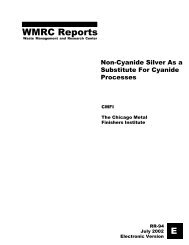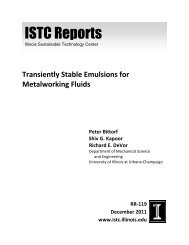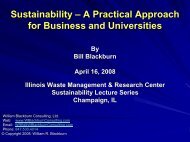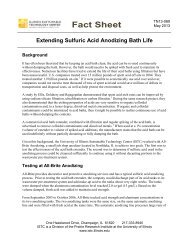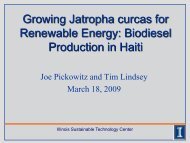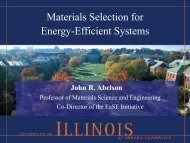Natural Resource Damage Assessment: Methods and Cases
Natural Resource Damage Assessment: Methods and Cases
Natural Resource Damage Assessment: Methods and Cases
You also want an ePaper? Increase the reach of your titles
YUMPU automatically turns print PDFs into web optimized ePapers that Google loves.
gives a histogram of the claims made in cases that used the Washington state compensation<br />
schedule method. These claims are mostly moderate in size. While few exceed $25,000 (though<br />
the largest case involved a claim for over a million dollars), almost none are lower than $100.<br />
Figure 2.5 provides a scatter-plot of the value of NRD claimed against the volume of the<br />
spill in each of the cases for which the compensation schedule was used. The biggest cases were<br />
dropped from the graph in order to make the rest easier to display. While the claims do tend to be<br />
larger when the spill is bigger, the schedule is complex enough that the correlation between these<br />
two values is not perfect. For all 209 cases in the data set the correlation coefficient is 0.94, but<br />
when the largest five spills are dropped the correlation coefficient drops to 0.80.<br />
The Washington compensation schedule has many desirable features. It is inexpensive<br />
<strong>and</strong> easy to use, since it is designed to produce an estimate of damages using little more<br />
information than the type <strong>and</strong> volume of oil released <strong>and</strong> the location of the spill. Given its<br />
simplicity, this assessment method has a surprising amount of spill specificity, since the factors<br />
used to scale damages are calculated separately for each of a very large number of different<br />
geographic regions within the state. Many of the parameters used in the method were developed<br />
with the input of a knowledgeable scientific advisory board.<br />
The damage assessment formulas discussed above yield damage estimates that increase<br />
with the magnitude of the spill, proxies for the magnitude of the injury (e.g. vulnerability of<br />
different habitat types to mechanical injury <strong>and</strong> acute toxicity) <strong>and</strong> the length of time the injury is<br />
likely to persist. <strong>Damage</strong> estimates are likely to be higher in cases where the injured resources<br />
are of relatively great value. There are many places in the schedules where judgments of relative<br />
values are implicitly being made; four examples can be readily identified. First, spill<br />
vulnerability scores are higher in marine <strong>and</strong> estuarine areas if species of special importance<br />
(such as those thought to be endangered) are likely to have been affected. Second, spill<br />
vulnerability scores are higher in freshwater areas if the water system in question is important for<br />
benefits such as municipal water supply, recreation, or wildlife habitat. These scores are also<br />
higher if the water system is relatively pristine. Pristine water systems may actually be better<br />
able to recover from a spill than systems that are already highly degraded; this element of the<br />
SVS for freshwater spills seems to act as a measure of variation in the value of what is being<br />
injured. Third, the index of recreation vulnerability includes factors relevant to the social value<br />
of the damaged resource, since recreation vulnerability is a function of how many people<br />
participate in recreational activities in the area affected by a spill. Fourth, spill vulnerability<br />
scores are higher for freshwater wetl<strong>and</strong>s that are important (for example, those that harbor<br />
endangered species) or unusual.<br />
However, there is no unified, transparent mechanism through which the value to society<br />
of damaged resources is brought into the calculations; many features of the assessment schedules<br />
seem to impose arbitrary <strong>and</strong> possibly undesirable structures on the damages that are assessed.<br />
For example, the multipliers used to adjust monetary damages to lie between $1 <strong>and</strong> $50 are<br />
arbitrary; there is no a priori reason that the monetary damages caused per gallon of oil spilled in<br />
each of the four types of receiving environments should adhere to the same numerical range. In<br />
general, placing a cap on the amount of damages assessed may reduce incentives to prevent the<br />
most harmful oil spills. Also, in the marine <strong>and</strong> Columbia River compensation schedules,<br />
34



